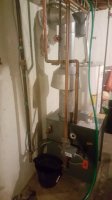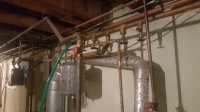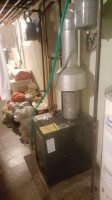FuzzyWuzzy
New Member
i have hydronic baseboard heating system set up in the basement in a two story house. ill start off by saying someone came and replaced the pressure relief valve and the expansion tank with a amtrol 15 one and we are still having the same issues. with everything shut off the pressure still slowly climbs. someone else suggested it might be a undersized expansion tank and to get a bigger one. at this point im not sure what's going on and ive already wasted money on someone who failed to fix my issue and am just looking for advice to see if its something i can tackle myself. ill post pictures shortly, the system is extremely old. i was thinking maybe the water shut off valve that adds water into the system is faulty? any help would be appreciated as its been slowly getting colder and colder.
some additional information, i have drained the entire system and water still gets added somehow, when the heating is on, ive observed it does stay steadyish at 180 degrees.
some additional information, i have drained the entire system and water still gets added somehow, when the heating is on, ive observed it does stay steadyish at 180 degrees.



